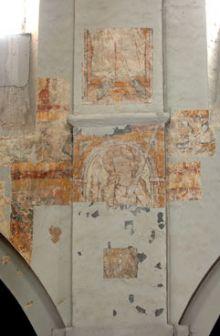Source: University of Michigan
Like X-rays let doctors see the bones beneath our skin, ¡°T-rays¡± could let art historians see murals hidden beneath coats of plaster or paint in centuries-old buildings, University of Michigan engineering researchers say.

T-rays, pulses of terahertz radiation, could also illuminate penciled sketches under paintings on canvas without harming the artwork, the researchers say. Current methods of imaging underdrawings can¡¯t detect certain art materials such as graphite or sanguine, a red chalk that some of the masters are believed to have used.
The team of researchers, which includes scientists at the Louvre Museum, Picometrix, LLC and U-M, used terahertz imaging to detect colored paints and a graphite drawing of a butterfly through 4 mm of plaster. They believe their technique is capable of seeing even deeper. A paper on the research is published in the February edition of Optics Communications.
In March, the scientists will take their equipment to France to help archaeologists examine a mural they discovered recently behind five layers of plaster in a 12th century church.
¡°It¡¯s ideal that the method of evaluation for historical artifacts such as frescoes and mural paintings, which are typically an inherent part of a building¡¯s infrastructure, be non-destructive, non-invasive, precise and applicable on site. Current technologies may satisfy one or more of these requirements, but we believe our new technique can satisfy all of them,¡± said John Whitaker, an author of the paper who is a research scientist and adjunct professor in the Department of Electrical Engineering and Computer Science at U-M.
Terahertz imaging can reveal depth and detail that other techniques cannot, Whitaker said. And it¡¯s not potentially harmful like X-ray imaging because terahertz radiation is non-ionizing. Its rays don¡¯t have enough energy to knock electrons off atoms, forming charged particles and causing damage, like X-rays do.
While terahertz radiation is all around us in nature, it has been difficult to produce in a lab because it falls between the capabilities of electronic devices and lasers.
¡°Terahertz is a strange range in the electromagnetic spectrum because it¡¯s quasi-optical. It is light, but it isn¡¯t,¡± said Bianca Jackson, first author of the paper who is a doctoral student in applied physics.
The device used for this research is a hybrid between electronics and lasers. It was developed by the Ann-Arbor based company Picometrix. It¡¯s called the T-Ray™ system, and it uses pulses from an ultra-fast laser to excite a semiconductor antenna, which in turn emits pulses of terahertz radiation.
The rays permeate the plaster, and some reflect back when there is a change in the material. When they bounce back and how much energy they retain depends on the material they hit. Different colors of paint, or the presence of graphite, for example, cause tell-tale differences in the amount of energy in the returning waves. A receiver measures this energy, and the scientists can use the data to produce an image of what lies beneath, Jackson explained.
A similar device made by Picometrix is used routinely to examine the foam on the space shuttle¡¯s fuel tanks for underlying damage, said Irl Duling, director of terahertz business development at Picometrix and an author of the paper. This paper discusses a new application, rather than a new device.
G¨¨rard Mourou, a U-M electrical engineering professor emeritus, said he believes this technique will be especially useful in Europe, where historic regime changes often resulted in artworks being plastered or painted over. This was common in places of worship, some of which switched from churches to mosques and vice versa over the centuries.
¡°In France alone, you have 100,000 churches,¡± Mourou said. ¡°In many of these places, we know there is something hidden. It has already been written about. This is a quick way to find it.¡±
And Leonardo DaVinci¡¯s ¡°The Battle of Anghiari,¡± for example, is believed to lurk beneath other frescos at the Palazzo Vecchio in Florence, Italy, Mourou said.
The paper is called ¡°Terahertz imaging for non-destructive evaluation of mural paintings.¡±

